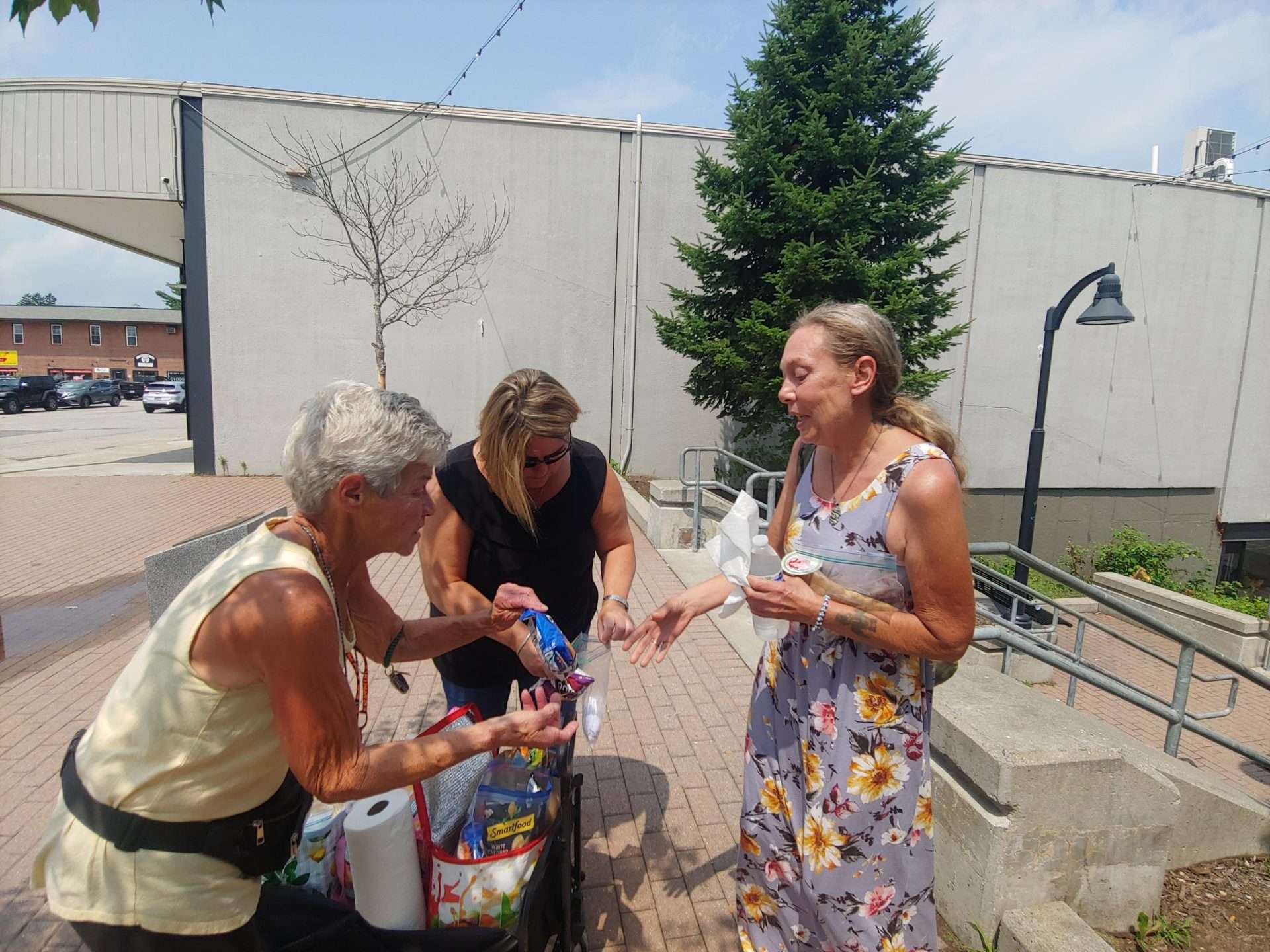
Roxanne Hatch, left, and Rebecca Harris, center, hand food items to Diana Bishop, who hadn’t eaten in two days.
Photo: Lee Burnett
By Lee Burnett
Three times a week, Roxanne Hatch pulls a wagon through Sanford’s downtown, delivering bottles of cold water, homemade sandwiches and other nourishment to street people. It’s one of the few served meals available to unhoused residents.
Hatch recently took some time off for surgery to repair a hernia, but she was back at it earlier this week with the assistance of Rebecca Harris, who drove down from Buxton to pull the wagon for her. She invited the Sanford Springvale News along to highlight the lives of Sanford’s street people, who have been far more visible at Gateway Park and Central Park since the June 17 closure of the large encampment at Heritage Crossing. We met at St. Ignatius apartments, where Hatch lives.
On this morning, Hatch had the wagon loaded with individually wrapped ham sandwiches, chicken-salad sandwiches, containers of applesauce, cookies, bottles of cold water, and packets of chips and pretzels. “Everything they like,” said Hatch. The food was prepared by Hatch and Harris with funds donated to It Takes a Village 207, the volunteer-driven assistance group serving unhoused people in southern Maine.
Before heading out, they were met by Alex, who had arrived by bicycle and who explained the latest laws being enforced in town. “It’s OK to hang out with all your belongings in a backpack, but if you spread it out and it looks like you’re settling down, they’ll hit you with loitering. We’ve been warned,” he said. “Everything is very perception-based.”
The women’s first stop was at Main Street Marketplace, where Hatch and Harris found a suntanned woman in a dress sitting halfway down the Gary Sullivan stairs and called to her by name. Diana Bishop met them at the top of the stairs and soon had her arms filled with food.
“These ladies, they’re angels,” said Bishop. “They really care.”
Bishop said she lives out of a car that she parks in front of a friend’s house. (Overnight parking at city parking lots is not allowed.) She said her last meal was two days earlier. “It’s hard work being homeless,” said Bishop. They all chatted a while more and when Harris and Hatch started to leave, Bishop reached out. “Give me a hug,” she said to Hatch. “I’m glad you’re out of the hospital.”
Feeding street people involves sidestepping the powers that be. One of the owners of the Main Street Marketplace has told them to stay off his sidewalks. (They’re legal on parking lots and stairs, which are city owned.) Their freelance approach also puts them at odds with city officials, some of whom have spoken publicly against individual acts of charity. Hatch and Harris say they have friendly relations with individual police officers. The city’s systematic, directed approach follows a 19-step strategy aligned with the US Interagency Council on Homelessness. The focus is on persuading street people to enter the emergency shelter system, where meals, beds and resources are available, but where life can feel institutional.
“That’s when the hair gets up on the back of my neck, when they say ‘you shouldn’t help,’” exclaims Harris. She also disagrees with the city’s closure of large homeless encampments prior to the expansion of other housing options. “I think there’s a better way.”
“If you don’t have housing and you don’t have food, what good are steps?” she asks, in reference to the U.S. Interagency Council on Homelessness’s 19 Strategies.
Hatch began her food service work as an outgrowth of walking her dog. “I’ve always been a social butterfly,” she said. As acquaintances developed with street people, she realized the prevalence of their hunger and began making cookies she donated to It Takes a Village 207. She prefers giving food to cash because she can stretch money further. She began preparing more food items and delivering them herself.
“I love her passion,” said Harris. “She can take five loaves and feed (the proverbial) 5,000 people. She will figure out how to do it.”
Harris got involved through a lifetime of working in food pantries. “I have a passion for helping the homeless,” she said. Since retiring at age 51 from a career as an insurance agent, she has more time to help. Her work is informed by both college coursework and her religious orientation. “Because of my religion, I don’t judge.”
“People need more than one meal a week. They also need love,” she said. “You say ‘angel,’ I say ‘meet them where they’re at.’”
This sentiment was applauded by York County Shelter Programs, which recently gave a shout-out to Hatch on the agency’s Facebook page.
“She knows where people congregate; she knows nearly everyone by name. She listens to peoples’ stories and she suggests resources. She is utterly present for those she encounters,” the post reads. “We are so grateful for people like Roxanne who are extending themselves like this. It does indeed take a village.”
The women rolled on through the Main Street Market parking lot to Central Park, where they were soon surrounded by a half dozen people and one young girl.






